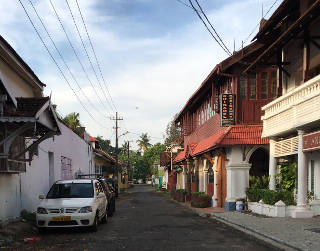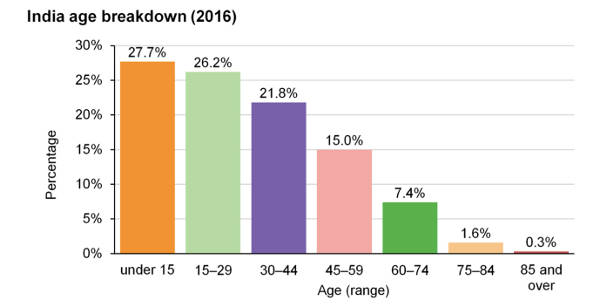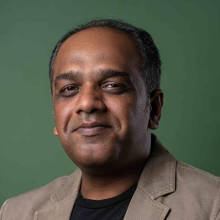[Image by Jérôme Choain from Pixabay]
By any which yardstick, Fort Kochi in Kerala is beautiful, prosperous and calm. While all of this attracts tourists from India and other parts of the world, it does very little to move me. Perhaps, it has much to do with that I am all too familiar with Kochi, where I used to spend my summer vacations as a boy.
What I am unfamiliar with now though is the turbulence that lurks below the calm. And I feel compelled to jot down a few thoughts basis some observations even as I peer out of a colonial-era home my grandparents once lived in. And my mother inhabits now. Alone.
Much to her exasperation, and that of her neighbours’, curiosity often compels many tourists to attempt to peer in. Many want to see what an old-world home looks like. In the early years, their arrival was greeted with much excitement because it brought prosperity. But over the years, they are increasingly viewed as a nuisance who have spoilt the social fabric and disturbed their calm.
I now visit every once a while, and for me, my mother, and her neighbours, the much-photographed streets remain the same—where my father played as a boy and grew up to serenade my mother. Much to her chagrin, the church, a few minutes away, where they married, is now a monument protected by the Archaeological Survey of India. Whatever is the fuss, she and everyone around, wonders?
All of them are in their seventies now. It only seems like yesterday when they were young, in synch with the world, and I was in awe. When I used to visit from Mumbai, everyone seemed rich. The homes around here are where I first heard the sounds of music from two-in-one music systems. This is also where I was first exposed to evenings where practically everyone huddled around colour televisions attached to a video cassette recorder (VCR), to watch a movie, as we sipped cold water from refrigerators in the hot summers.
And because power cuts were frequent, every home had “invertors”—a contraption I hadn’t seen anyplace else in India. And like magic, it could bring power back to lightbulbs and fans in a part of the country where power cuts are the norm. I suspect a version of this narrative can be extrapolated to any other Indian city such as Chandigarh, Vadodara, Indore, Jaipur, Vishakapatanam, or Nashik for that matter.
Back to Fort Kochi. That everyone here could afford these contraptions in the 1980s is what made it a prosperous place to an impressionable young boy. I now know this prosperity emerged on the back of money remitted by a workforce that had migrated to the Middle East and other parts of the country such as Mumbai and Delhi in search for work.

[Those who continue to live in places such as Fort Kochi can afford to pay for more expensive purchases.].
While demand fuelled by the Middle East boom has practically ended, all thanks to progressive public policies and entrepreneurial chutzpah, those who continue to live in places such as Fort Kochi can afford to pay for more expensive purchases than city slickers like me and the propensity to acquire the latest remains high. If any evidence be needed, it stares at me from every home I visit.
Ironically, this is where the dichotomies emerge as well.
Most of the days I am around the place, I am inevitably tasked by the mother to fix somebody’s “malfunctioning” phone, computer, software, link Aadhaar numbers to bank accounts, recover a password, and so on and so forth.
“Something is the matter. It isn’t working,” was the most common refrain. After attending to each request to keep the mother in good humour, turns out, nothing is the matter. The auto update feature on most of the phones, for instance, had just downloaded a newer version or a software upgrade. Once the device rebooted, all would be well.
Then there were questions of all kinds I first imagined were inane and lazy. Most questions from those in the sixties and seventies often sounded naïve to someone in his mid-forties. Irritation finally gave way to curiosity and compelled me to listen. What is it everyone is asking and has them exasperated?
1. “See son, I need to add a few phone numbers. How do I it?”
In theory, this ought to be one of the most intuitive things to do on modern cellular phones. But turns out, it isn’t. Practically no one in the vicinity knew how to input data into a high-end touch screen device. On examining their phones, turns out, most apps were unused, save the camera to click pictures and WhatsApp to send messages. The numbers that existed on their devices were saved when someone, like me, visited home or they felt compelled to visit a so-called “service centre”.
Ironically, they were comfortable feeding data into devices with an old form factor and which younger people now think of as having a complicated interface—such as the first-generation Nokia cellular phones that were the rage once upon a time.
The easiest thing for a senior citizen to do then is carry an older device they are comfortable with. But when asked why they don’t prefer that, they admit with much reluctance it would be perceived as a hand-me-down device intended for the “workers”. That the “workers” don’t want “dumb phones”, are younger, and comfortable with smartphones, is different story.
2. “What is this OTP business? It seems we have to link all our bank accounts and an OTP is needed. A nice fellow at the bank did everything. But he said to complete the request, an OTP will be sent to my phone and that is something I must put somewhere on the internet. Where do I put it on the internet?
I dealt with this over and over again. Some questioning later, evidently, the friendly banker whom they have known for decades, had created a login and a password, written it down on a piece of paper, and handed it over to them with instructions on what protocols to follow. But in the most literate Indian state, the older generation is having a tough time trying to wrap their heads around the idea of a one time password (OTP). And that this is an additional security feature that must not be shared with anyone and has a limited validity period.
My mother, for instance, was attempting to figure out for three months how to input an OTP that was valid for 15 days from the time it hit her phone. What exacerbated the problem was that the OTP did not originate from a number, but from a Pension Office that has a text-based identity, which is the norm now. Nor did anyone around her know how to find it or where to input it. All she knew was, “The OTP must be typed into the internet.”
It took a very long time to explain that the sender may have an identity and that the internet is a vast place. Eventually, I gave up and just did what had to be done. But what it did point to is, while technology makes life easy, there is a group of people it leaves vulnerable and feeling utterly helpless.
3. “We have heard of something called Zomato and Swiggy. They say they deliver food from everywhere. And what is this Amazon thing? How to order all this on the phone? If I can do it, that Martin fellow will have to bring his prices down.”
Again, it took a while and much doing to explain apps, and how they can be downloaded from the App Store or Play Store. Uber and Ola were much sought after as well. Much time was spent creating accounts for people and offering tutorials on how to use it. But once again, when the app would insist on an OTP to authenticate their credentials, it created another hurdle and we’d be back to square one.
My colleague NS Ramnath often describes the premium people in this group pay because they cannot use the technology as a “tax” of a kind. He is right, literally.
Hailing an auto or a taxi in Kochi isn’t easy (like in most Tier II Indian cities). And when you finally find one, the rider must pay the driver a premium so he can return to his designated stand. If they knew how to use a ride hailing app on the other hand, people such as my mother would pay only to get from Point A to Point B. Or call for food of her choice at a time of her choosing without having to depend on Martin’s whims.
The issues were universal. A few questions crossed the mind.
- With a literacy rate in excess of 93%, how did this technological naiveté come about? Is this an engineering and design failure? Is it possible, food delivery and ride sharing apps are missing out on a market opportunity by not designing for people such as these?
- Or is it that those who could afford the technologies earlier and can still do, simply stop learning?
- For that matter, did technology simply outpace them? If that be true, what may happen to me and my generation as we grow older?
Some walks on the beachfront and through the lanes and bylanes of Fort Kochi later, pointers on how to examine the questions occurred, much of it basis conversations Ramnath and I had engaged in while reporting to write The Aadhaar Effect (the book was published late last year).
All technologies are engineered so they are accessible to the largest numbers of people. When looked at from that prism, India is still a very young country. Only 9% of its people are over 60.

[Source: Encyclopedia Britannica]
A data scientist I spoke to at an Indian unicorn said Indian entities are collecting data and monitoring how this segment behaves. When looked at clinically, he pointed out, the market isn’t large enough to service them. They are not a profitable segment yet. So, the problem facing older citizens isn’t one created by bad engineers.
It is just that the technologies are crafted to meet what younger people may want because that is where the markets are and the profits lie. It is just an issue of demand and supply.
In parts of the world, where the numbers of people over age 60 are growing, public services and businesses are adapting to meet their demands. The New York Times reports how airports across the country are being redesigned and hotel companies are making subtle shifts in their strategies. All of this has to do with that by next year, the number of people aged 60 and over will outnumber children younger than five years. And by 2050, there will be at least 2 billion people on Earth older than 60.
That is when it occurred to me that if I look at Fort Kochi as a microcosm of how the future is unfolding given the rate at which technology is growing and outpacing people, what may my future look like?
Something that Shankar Maruwada, co-founder at the EkStep Foundation, had to say in an altogether different conversation, came to mind. As adults, most of us forget how to learn, unlearn, and learn again. By way of example, once upon a time, medical knowledge doubled every 50 years. It now doubles every 72 days. What it means is we live in an era where medical graduates are outdated even as degrees are conferred upon them.
I had delved into the implications of this on Founding Fuel two years ago. Disruptions such as these are happening across all domains. To deal with changes such as this, Maruwada says, “adaptive expertise” is needed. The residents here did not adapt. If I continually adapt and accept that continual learning and multiple careers in a single lifetime are inevitable, then no, I ought not to be worried. This, assuming age-related illnesses do not compel me to slow down.
Having said that, like I articulated earlier, I thought I could hear the sounds of much turbulence below the calm. I could hear why when I walked along the beach one day. There was much chatter by young people in Odia, Bangla and Bhojpuri. Their numbers and their voices have been growing over the years. What was once a trickle has turned into an avalanche. There are streets that serve food from these parts of the country, cinemas that screen movies in these languages and places where Malayalam-speakers are outnumbered.
While their services are in demand, because they work hard, and work well, they are viewed with much suspicion as well. Their language and culture sounds alien to residents. Hindiwala is what anyone from north of Karnataka is called. Ironically, it wasn’t too long ago that anyone south of Karnataka was called a Madrasi.
This is the kind of thing that ought to get the attention of public policy wonks. A pointer to what is happening occurs in a 2016 research paper on the Youth in India by Kasturi Naik and Anita Bobade. “A dichotomous situation exists in India with respect to youth employment. On one hand, not enough people are getting jobs and on the other, there isn‘t enough skilled labour in the country. From perspective of the technology industry, a huge portion of the population has been excluded from employment due to lack of availability of skilled employees. Unlike in manufacturing, where a number of low-skilled jobs exist, the technology industry has completely stayed away from generating such jobs.”
The tensions are simmering. But the Madrasi needs the Hindiwala. As much as the Hindiwala needs the Madrasi.
Both know it.

